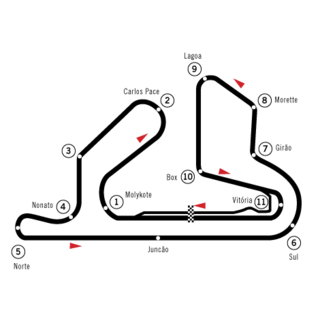
The 1978 British Grand Prix was a Formula One motor race held at Brands Hatch on 16 July 1978. It was the tenth race of the 1978 World Championship of F1 Drivers and the 1978 International Cup for F1 Constructors.

The 1979 British Grand Prix was a Formula One motor race held at Silverstone on 14 July 1979. It was the ninth race of the 1979 World Championship of F1 Drivers and the 1979 International Cup for F1 Constructors.

The 1979 Italian Grand Prix was a Formula One motor race held on 9 September 1979 at Monza. It was the thirteenth race of the 1979 World Championship of F1 Drivers and the 1979 International Cup for F1 Constructors.

The 1981 Italian Grand Prix was a Formula One motor race held at Monza on 13 September 1981. It was the thirteenth race of the 1981 Formula One World Championship.

The 1982 Austrian Grand Prix was a Formula One motor race held at Österreichring on 15 August 1982. It was the thirteenth race of the 1982 Formula One World Championship.

The 1983 South African Grand Prix was a Formula One motor race held at Kyalami on 15 October 1983. It was the fifteenth and final race of the 1983 Formula One season. The 77 lap race was won by Riccardo Patrese driving for Brabham. This would be Patrese's last win for nearly seven years until he won for Williams at the 1990 San Marino Grand Prix.

The 1984 Brazilian Grand Prix, officially known as the XIII Grande Prêmio Brasil de Fórmula 1 was a Formula One motor race held on 25 March 1984 in Rio de Janeiro. The race was contested over 61 laps of Jacarepaguá Circuit and was the first race of the 1984 Formula One World Championship. This race was the 13th edition of the Brazilian Grand Prix, the ninth time that the Jacarepaguá Circuit race held a Grand Prix, and marked the debut of Ayrton Senna in Formula One.

The 1984 South African Grand Prix was a Formula One motor race held at Kyalami on 7 April 1984. It was race 2 of 16 in the 1984 Formula One World Championship. The 75-lap race was won by Niki Lauda, driving a McLaren-TAG, with teammate Alain Prost second and Derek Warwick third in a Renault.

The 1984 Austrian Grand Prix was a Formula One motor race held at Österreichring on 19 August 1984. It was the twelfth race of the 1984 Formula One World Championship, and the 400th Grand Prix held as part of the World Championship since it began in 1950.

The 1984 Italian Grand Prix was a Formula One motor race held at Monza on 9 September 1984. It was the fourteenth race of the 1984 Formula One World Championship.

The 1983 FIA Formula One World Championship was the 37th season of FIA Formula One motor racing. It featured the 1983 Formula One World Championship for Drivers and the 1983 Formula One World Championship for Manufacturers, which were contested concurrently over a fifteen-race series that commenced on 13 March and ended on 15 October.

The 1979 Formula One season was the 33rd season of FIA Formula One motor racing. It featured the 1979 World Championship of F1 Drivers and the 1979 International Cup for F1 Constructors which were contested concurrently over a fifteen-round series which commenced on 21 January 1979, and ended on 7 October. The season also included three non-championship Formula One races.

The BRM P160 was a Formula One racing car designed by Tony Southgate for the British Racing Motors team, which raced in the 1971, 1972, 1973 and 1974 Formula One seasons. It was powered by a 3.0-litre V12 engine.

The Brabham BT50 was a Formula One racing car designed by Gordon Murray and powered by a turbo BMW engine. It was raced by the Brabham team, owned by Bernie Ecclestone, during the 1982 Formula One season. Driven by Nelson Piquet and Riccardo Patrese, it made its debut at the South African Grand Prix before being withdrawn for further development of its engine while the team reverted to the previous year's car, the Brabham BT49. On the reintroduction of the BT50, Piquet finished fifth in the Belgian Grand Prix. A few races later he drove it to a win in the Canadian Grand Prix. Later in the year it achieved three more finishes in the points for the team. During the second half of the season, Brabham implemented the strategy of mid-race refueling. This allowed Piquet and Patrese to start the races relatively light and use their reduced weight to gain track position over their competitors before stopping to refuel. The poor reliability of the BT50 meant that they had only a few opportunities to demonstrate the strategy in practice.

The Williams FW was a Formula One car used by Frank Williams Racing Cars during the 1973, 1974 and 1975 seasons. It was designed by John Clarke.

The Fittipaldi FD was a series of Formula One chassis designed by Richard Divila and used by Fittipaldi Automotive in the 1975, 1976 and 1977 seasons. The initial chassis was designated Fittipaldi FD01 and there were three minor developments designated, Fittipaldi FD02, Fittipaldi FD03 and Fittipaldi FD04 respectively. FD series cars competed in 37 races making 43 individual entries in total. The chassis achieved a best finish of fourth place at both the 1977 Argentine and Brazilian Grands Prix driven on each occasion by former World Champion and joint team-owner Emerson Fittipaldi. It scored a total of 11 World Championship points.

The Surtees TS9 was a Formula One car used by Surtees during the 1971, 1972 and 1973 Formula One seasons. It was designed by John Surtees and Peter Connew.

The Surtees TS14 was a Formula One car used by Surtees during the 1972 and 1973 Formula One seasons. It was designed by John Surtees.

The Surtees TS19 was a Formula One (F1) car used by Surtees during the 1976, 1977 and 1978 F1 seasons. It was designed by John Surtees and Ken Sears.

The Brabham BT34 was a Formula One racing car designed by Ron Tauranac, and used by Brabham during part of the 1971 and 1972 Formula One seasons.















